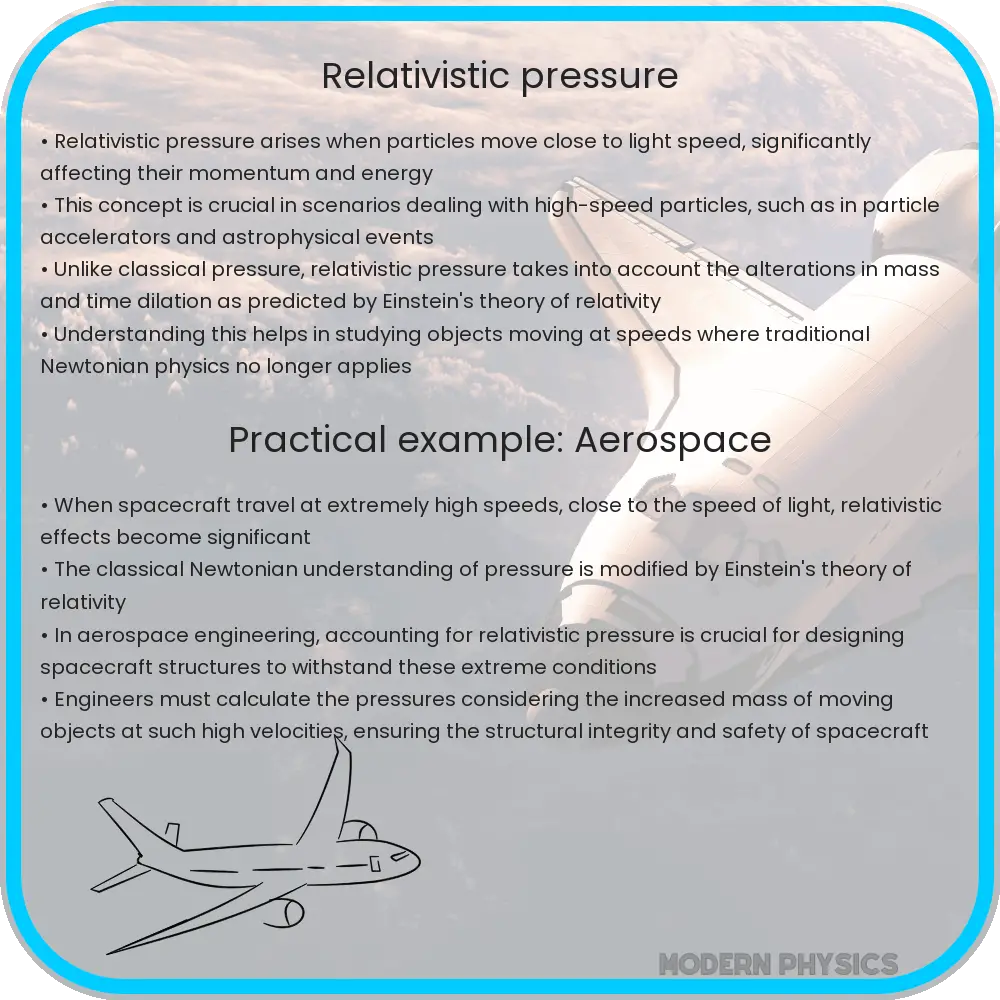Explore the fascinating concept of relativistic pressure in special relativity, its mathematical basis, and applications in astrophysics and particle physics.

Understanding Relativistic Pressure in Special Relativity
In the realm of physics, the concept of relativistic pressure becomes crucial when discussing scenarios involving objects moving at speeds close to that of light. This concept, rooted in the principles of Einstein’s Special Theory of Relativity, explains how pressure, like time and length, is affected by high-velocity conditions. To grasp this phenomenon, it is essential to first understand the fundamentals of Special Relativity and how it alters our perception of space, time, and now, pressure.
Special Relativity: A Brief Overview
Special Relativity, proposed by Albert Einstein in 1905, revolutionized the way we understand the interplay of space and time. Central to this theory are two key postulates: the laws of physics are invariant in all inertial frames of reference, and the speed of light in vacuum is the same for all observers, regardless of the motion of the light source or observer. The implications of these postulates are profound, leading to effects such as time dilation and length contraction, observable at speeds approaching the speed of light.
Pressure in Classical Physics
Traditionally, pressure is defined as the force exerted per unit area. In classical physics, this definition suffices for most scenarios. However, as velocities increase to significant fractions of the speed of light, classical definitions and formulas no longer hold true. This discrepancy is where relativistic pressure comes into play.
Relativistic Pressure: Core Concept
Relativistic pressure can be understood as the modification of the classical concept of pressure when taking into account the effects of Special Relativity. At high velocities, not only do spatial dimensions contract (length contraction), but the distribution and interaction of forces also change. This change impacts how pressure is experienced and measured in a relativistic context. The relativistic formula for pressure incorporates factors that account for these high-speed effects, ensuring accurate descriptions of physical phenomena in extreme conditions.
One of the key implications of relativistic pressure is its role in understanding the behavior of high-velocity particles in physics, particularly in areas like astrophysics and particle physics. For example, in the study of neutron stars and black holes, where immense gravitational forces result in near-light-speed movements, the concept of relativistic pressure is indispensable for accurate modeling and understanding.
Another application is in the field of particle accelerators, where particles are accelerated to speeds close to that of light. Here, understanding how pressure behaves under these conditions is crucial for the design and safe operation of these complex machines.
In the next section, we will delve deeper into the mathematical formulation of relativistic pressure, its derivation, and further applications in modern physics.
Mathematical Formulation of Relativistic Pressure
The mathematical formulation of relativistic pressure is derived from the principles of Special Relativity and thermodynamics. At relativistic speeds, the pressure \( P \) and volume \( V \) of a gas are no longer independent but are influenced by the Lorentz factor \( \gamma \), which is defined as \( \gamma = \frac{1}{\sqrt{1 – \frac{v^2}{c^2}}} \), where \( v \) is the velocity of the gas and \( c \) is the speed of light. The relativistic pressure equation modifies the classical ideal gas law to account for these high-speed effects.
The relativistic version of the ideal gas law can be expressed as:
\[ P = \gamma \times P_{classical} \]
where \( P_{classical} \) is the pressure calculated using the classical ideal gas law. This equation shows how pressure increases as the velocity of the gas approaches the speed of light.
Applications in Cosmology and Particle Physics
In cosmology, relativistic pressure plays a significant role in understanding the early universe, especially during the Big Bang and subsequent inflationary period. The high-energy conditions of the early universe necessitate the use of relativistic physics to accurately describe the behavior of matter and radiation.
In particle physics, relativistic pressure is vital in the study of high-energy particle collisions, such as those observed in particle accelerators like the Large Hadron Collider (LHC). These collisions occur at speeds close to that of light, and understanding the relativistic effects on pressure is crucial for predicting the outcomes of these experiments and for the safety and design of the accelerators.
Conclusion
Relativistic pressure, an extension of classical pressure concepts within the framework of Special Relativity, is pivotal in understanding and predicting phenomena in high-velocity regimes. From the behavior of cosmic bodies like neutron stars and black holes to the intricate workings of particle accelerators, relativistic pressure offers a more accurate and comprehensive understanding of these high-speed environments. Its integration into modern physics not only underscores the ingenuity of Einstein’s theories but also continues to push the boundaries of our knowledge, enabling deeper insights into the fabric of our universe and the fundamental forces that govern it.
In summary, the study of relativistic pressure is not just an academic exercise; it is a fundamental aspect of understanding the universe at its most extreme, providing crucial insights into the realms of astrophysics, cosmology, and particle physics. As we continue to explore the universe and push the limits of high-speed physics, the concept of relativistic pressure will undoubtedly play a vital role in shaping our understanding of the cosmos.
